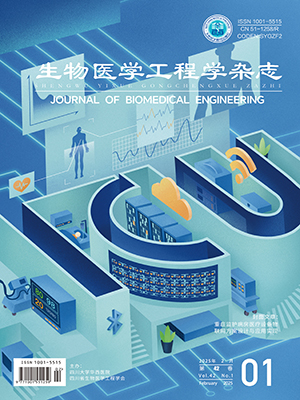| 1. |
夏思萍, 徐雅洁, 余颖聪, 等. 经颅磁刺激电场分析研究进展. 中国生物医学工程学报, 2020, 39(6): 727-735.
|
| 2. |
Giacomo K, Paolo C E, Sonia B, et al. Precuneus magnetic stimulation for Alzheimer's disease: a randomized, sham-controlled trial. Brain, 2022, 145(11): 3730-3732.
|
| 3. |
Zhang B B B, Stohrmann P, Godbersen G M, et al. Normal component of TMS-induced electric field is correlated with depressive symptom relief in treatment-resistant depression. Brain Stimul, 2022, 15(5): 1318-1320.
|
| 4. |
张新, 李建军. 经颅磁刺激研究及应用进展. 中国康复理论与实践, 2006, 12(10): 879-882.
|
| 5. |
Bae E H, Schrader L M, Machii K, et al. Safety and tolerability of repetitive transcranial magnetic stimulation in patients with epilepsy: a review of the literature. Epilepsy Behav, 2007, 10(4): 521-528.
|
| 6. |
Valiengo L, Pinto B S, Marinho K A P, et al. Treatment of depression in the elderly with repetitive transcranial magnetic stimulation using theta-burst stimulation: study protocol for a randomized, double-blind, controlled trial. Front Hum Neurosci, 2022, 16: 941981.
|
| 7. |
Saturnino G B, Puonti O, Nielsen J D, et al. SimNIBS 2.1: A comprehensive pipeline for individualized electric field modelling for transcranial brain stimulation// Makarov S, Horner M, Noetscher G. Brain and Human Body Modeling: Computational Human Modeling at EMBC 2018. Cham (CH): Springer, 2019: 3-25.
|
| 8. |
Madsen K H, Ewald L, Siebner H R, et al. Transcranial magnetic stimulation: an automated procedure to obtain coil-specific models for field calculations. Brain Stimul, 2015, 8(6): 1205-1208.
|
| 9. |
Gomez L J, Dannhauer M, Peterchev A V. Fast computational optimization of TMS coil placement for individualized electric field targeting. Neuroimage, 2021, 228: 117696.
|
| 10. |
Weise K, Numssen O, Thielscher A, et al. A novel approach to localize cortical TMS effects. Neuroimage, 2020, 209: 116486.
|
| 11. |
Wagner T, Gangitano M, Romero R, et al. Intracranial measurement of current densities induced by transcranial magnetic stimulation in the human brain. Neurosci Lett, 2004, 354(2): 91-94.
|
| 12. |
Louviot S, Tyvaert L, Maillard L G, et al. Transcranial electrical stimulation generates electric fields in deep human brain structures. Brain Stimul, 2022, 15(1): 1-12.
|
| 13. |
Shan Y, Wang H, Yang Y, et al. Evidence of a large current of transcranial alternating current stimulation directly to deep brain regions. Mol Psychiatry, 2023. DOI: 10.1038/s41380-023-02150-8.
|
| 14. |
Sperandio M, Guermandi M, Guerrieri R. A four-shell diffusion phantom of the head for electrical impedance tomography. IEEE T Bio-med Eng, 2012, 59(2): 383-389.
|
| 15. |
Afuwape O F, Oya H, Boes A D, et al. Measurement and modeling of the effects of transcranial magnetic stimulation on the brain. IEEE T Magn, 2021, 57(2): 5800205.
|
| 16. |
Opitz A, Windhoff M, Heidemann R M, et al. How the brain tissue shapes the electric field induced by transcranial magnetic stimulation. Neuroimage, 2011, 58(3): 849-859.
|
| 17. |
Thielscher A, Opitz A, Windhoff M. Impact of the gyral geometry on the electric field induced by transcranial magnetic stimulation. Neuroimage, 2011, 54(1): 234-243.
|
| 18. |
Zhang J, Yang B, Li H, et al. A novel 3D-printed head phantom with anatomically realistic geometry and continuously varying skull resistivity distribution for electrical impedance tomography. Sci Rep, 2017, 7(1-4): 4608.
|
| 19. |
Magsood H, Hadimani R L. Development of anatomically accurate brain phantom for experimental validation of stimulation strengths during TMS. Mater Sci Eng C Mater Biol Appl, 2021, 120: 111705.
|
| 20. |
Wu S, Zhang J, Ladani R B, et al. Novel electrically conductive porous PDMS/carbon nanofiber composites for deformable strain sensors and conductors. ACS Appl Mater Inter, 2017, 9(16): 14207-14215.
|
| 21. |
Smith J E, Peterchev A V. Electric field measurement of two commercial active/sham coils for transcranial magnetic stimulation. J Neural Eng, 2018, 15(5): 054001.
|
| 22. |
Nieminen J O, Koponen L M, Ilmoniemi R J. Experimental characterization of the electric field distribution induced by TMS devices. Brain Stimul, 2015, 8(3): 582-589.
|
| 23. |
Thielscher A, Antunes A, Saturnino G B. Field modeling for transcranial magnetic stimulation: A useful tool to understand the physiological effects of TMS? //2015 37th Annual International Conference of the IEEE Engineering in Medicine and Biology Society (EMBC). Milan: IEEE, 2015: 222-225.
|
| 24. |
Wagner T A, Zahn M, Grodzinsky A J, et al. Three-dimensional head model simulation of transcranial magnetic stimulation. IEEE T Bio-med Eng, 2004, 51(9): 1586-1598.
|
| 25. |
石玉秀. 组织学与胚胎学. 北京: 高等教育出版社, 2007: 123-128.
|
| 26. |
蔡昌平. 局部解剖学. 第2版. 北京: 科学出版社, 2021: 10.
|




